2018 Trade Value: #11 to #20

(Photo: Erik Drost)
As is the annual tradition at FanGraphs, we’re using the week of the All-Star Game — while (some of) the industry pauses to take a metaphorical breather — to take stock of the top-50 trade assets in the sport. For more context on exactly what we’re trying to do here, see the honorable-mentions post linked at the top of the page.
For this post and the others in this series, I’ve presented a graphic (by way of the wizard Sean Dolinar) breaking down each player’s objective skill level (represented, in this case, by a five-year WAR projection from ZiPS), contract/team-control details, rank in last year’s series, and then year-by-year details of age/WAR/contract through 2023, although a couple players have control beyond those five years. For those readers who are partial to spreadsheets rather than blocks of text, I’ve also included all the players we’ve ranked so far are in grid format at the bottom of the post.
The ZiPS WAR forecasts did influence the rankings a bit: for players who were bunched together, it acted as an impartial tiebreaker of sorts, but the industry opinions I solicited drove the rankings.
With that said, let’s get to the next 10 spots on the Trade Value list this year.
| Five-Year WAR | +17.2 |
| Guaranteed Dollars | – |
| Team Control Through | 2024 |
| Previous Rank | – |
| Year | Age | Projected WAR | Contract Status |
|---|---|---|---|
| 2019 | 22 | +2.3 | Pre-Arb |
| 2020 | 23 | +3.0 | Pre-Arb |
| 2021 | 24 | +3.8 | Arb1 |
| 2022 | 25 | +4.0 | Arb2 |
| 2023 | 26 | +4.1 | Arb3 |
Torres was our 12th-ranked prospect entering the year and, while that top tier has mostly stayed where they are (except for party-crashed Juan Soto), there’s been a shuffle of the name up top. Torres is one of the players to whom I refer in the introduction who wouldn’t have appeared on this list before the season began (although he would’ve been in the mix for an honorable mention) but whom it would be insane to exclude now. The difference? Just 63 big-league games. If Torres had no pedigree and was pulling some Shane Spencer or Bo Hart business, this wouldn’t be the case, as his age, pedigree, and track record have all suggested this sort of thing was on the table.


